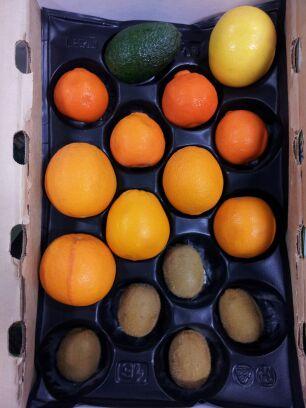THIS WEEKS FRUIT
Navel Oranges
Olsen Organic Farm, Lindsay, CA
California Navel Oranges are considered to be the best Navels for eating out of hand. They have a thick skin that is easy to peel, are seedless, and have a meaty and sweet flesh that makes them a perfect snack. Navels are also great for juicing and cooking. Store out of sunlight for 2-4 days on the counter or up to two weeks in the fridge.
Minneola Mandarins
Sundance Natural, Oceanside, CA
Minneolas are a cross between a grapefruit and a mandarin. Their peel is a smooth orange-red. The shape slightly resembles a bell with a round body and pronounced neck. Minnoelas have a juicy sweet flavor with a hint of tartness harkening to their grapefruit parentage. Store out of sunlight for 2-4 days on the counter or up to two weeks in the fridge.
Ruby Grapefruit
Sundance Natural, Oceanside, CA
The Grapefruit is said to cross between the Jamaican sweet orange and the Indonesian pomelo, first documented in 1750. Red grapefruit was an accidental discovery of a red fruit growing on a pink grapefruit tree. They are prized for their beautiful color and sweet flesh. Store out of sunlight for 2-4 days on the counter or up to two weeks in the fridge.
Hayward Kiwi
Chieci Farm, Live Oak, CA
Originally known as the Chinese gooseberry due to its Chinese origins. Hawyward Wright, a New Zealand nurseryman propagated his plants by grafting and they eventually became the preferred cultivar of growers due to their sweet flavor and thin skin. The kiwis are ripe and ready to eat upon arrival. Consume first or store in the fridge.
Hass Avocado
Tomorrow’s Organic, Monterey, CA
Creamy in texture, nutty in flavor, with a small to medium seed. The Hass skin is easy to peel and darkens from green to purplish-black as it ripens.
A NOTE FROM FARMER AL
Gopher Love?
Dear CSA Members,
This last Tuesday, just prior to the recent storms, we were planting trees. Our goal was to get the planting done before the rains came, mak- ing the soil impossible to dig. We were in the pear orchard re-planting 60 Golden Russet Bosc trees which had been killed by the dreaded Fire Blight, a bacterial disease, which had been killing trees for several years since the last wet Spring 3 years ago.
In planting the bare root trees the men were digging holes in the soil which were still muddy from the rains earlier in February. Covering the bare roots of the new trees with these heavy slabs of mud was not good, so I asked the men to use the top 3 inches of the surface soil to back fill the roots in the just dug holes. It turns out, that there was lots of very fine, loose, and fairly dry soil everywhere in the orchard-soil which had been excavated by armies of gophers. I had finally discovered a reason to actu- ally appreciate these dastardly devils…they provided us with really fine soil which made the replanting process easier and made for great, thorough coverage of the roots of the trees…no air pockets. With the heavy rain which followed the very next day, the replanted trees will get off to a really rigorous start.
Our next challenge, once they start growing, will be to protect their roots from the very same gophers who aided them in their healthy start.

 Follow
Follow

